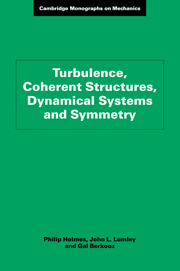11 - Some other fluid problems
Published online by Cambridge University Press: 03 February 2010
Summary
The methods developed in this book may be applied rather generally to model the dynamics of coherent structures in spatially extended systems. They are gaining acceptance in many areas in addition to fluid mechanics, including mechanical vibrations, laser dynamics, non-linear optics, and chemical processes. They are even being applied to studies of neural activity in the human brain. Numerous studies of closed flow systems have been done using empirical eigenfunctions, some of which were discussed in Section 3.7. A considerable amount of work has also been done on model PDEs for weakly non-linear waves, such as the Ginzburg–Landau and Kuramoto–Sivashinsky equations, which falls largely outside the scope of this book. We do not have the abilities (or space) to provide a survey of these multifarious applications, but we do wish to draw the reader's attention to some of the other recent work on open fluid flows.
We restrict ourselves to studies in which empirical eigenfunctions are used to construct low-dimensional models and some attempt is made to analyse their dynamical behavior. There is an enormous amount of work in which the POD is applied and its results assessed in a “static,” averaged fashion. Some of this we have reviewed in Section 3.7. Yet even thus restricted, our survey cannot pretend to be complete: new applications to fluid flows are appearing at an increasing rate. We have selected five problems on which a reasonable amount of work has been done, one of which (the jet) is a “strongly” turbulent flow.
- Type
- Chapter
- Information
- Turbulence, Coherent Structures, Dynamical Systems and Symmetry , pp. 349 - 375Publisher: Cambridge University PressPrint publication year: 1996

